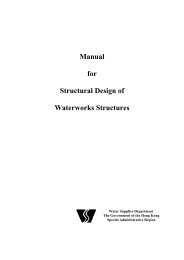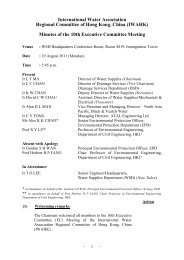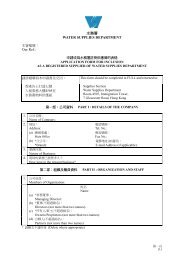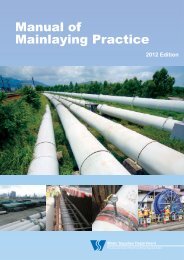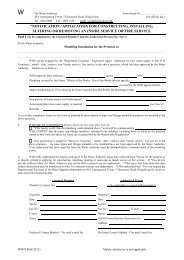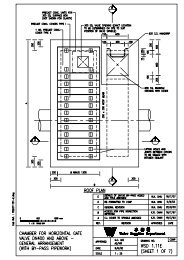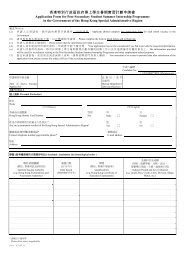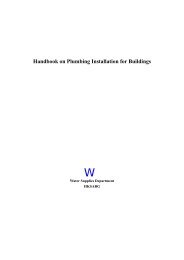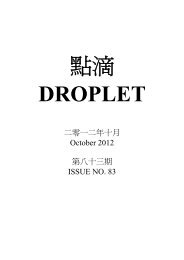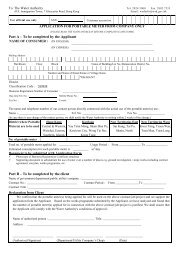Manual of Mainlaying Practice
Manual of Mainlaying Practice
Manual of Mainlaying Practice
Create successful ePaper yourself
Turn your PDF publications into a flip-book with our unique Google optimized e-Paper software.
- 36 -The advantages and disadvantages <strong>of</strong> various methods <strong>of</strong> rehabilitation aresummarised in Appendix 4.2 for reference.4.4.4 Procedures for Rehabilitation <strong>of</strong> Water MainsThe procedures for rehabilitation <strong>of</strong> water mains by various methods havebeen consolidated from the submissions furnished by the contractors <strong>of</strong> recentR&R contracts, and are for general reference only. Engineers and inspectorsare advised to exercise their own judgments in adopting the most suitablemethod <strong>of</strong> rehabilitation and evaluating the method statements submitted bycontractors, taking into account <strong>of</strong> all relevant site specific factors, including,but not limited to, the availability <strong>of</strong> space and the condition <strong>of</strong> the existingmain to be rehabilitated.Close Fit LiningStep 1: Preparatory WorkConstruct a launching pit (for insertion <strong>of</strong> PE close fit lining and towing head)and a receiving pit (for accommodation <strong>of</strong> winch and associated equipment).Step 2: Pre-lining CCTV Survey, Pipe Cleaning and Local RepairCarry out CCTV survey to assess the condition <strong>of</strong> the host pipe. Clean thepipe to remove silt, rust, tuberculation, deposits, remains and other foreignmaterials by means <strong>of</strong> wire brushes, scraper or pressure jetting. Carry outCCTV survey again as necessary to confirm that the host pipe has beencleaned satisfactorily. For mains to be rehabilitated by semi-structural lining,carry out local repair works for the host pipe as necessary.Step 3: Removal <strong>of</strong> ObstructionsIdentify possible obstructions, such as protruding branch connections,displacement at joints or excessive deformation <strong>of</strong> the host pipe, and removethe obstructions before commencement <strong>of</strong> installation <strong>of</strong> lining.Step 4: Measurement <strong>of</strong> Dimension <strong>of</strong> Host PipeUse an appropriate prover <strong>of</strong> dimensions and/or carry out laser measurementsfor measuring the internal diameter and ovality <strong>of</strong> the host pipe to confirmsuitability <strong>of</strong> the proposed lining, and to ensure its free passage along the hostpipe.Step 5: Temporary Deformation <strong>of</strong> LiningFold the lining into C-shape in factory or in-situ on site by a suitabledeforming device to facilitate the winching <strong>of</strong> the deformed lining from thelaunching pit to the receiving pit. Alternatively, deform the liningconcentrically (by reducing its diameter) by swaging through a set <strong>of</strong> static dierollers or an array <strong>of</strong> compression rollers, to facilitate the insertion to the host



